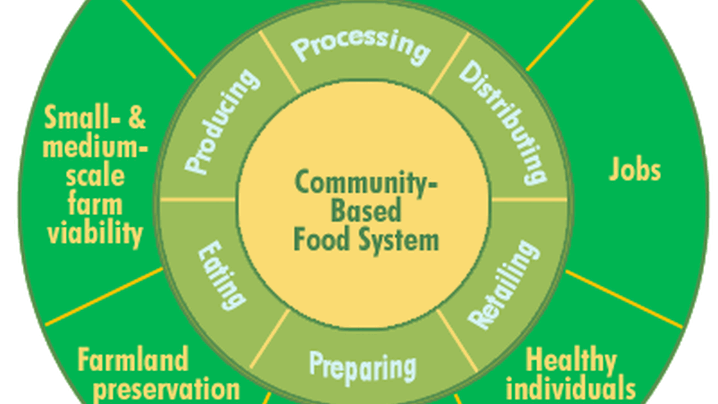
We are what we eat.
Beyond the typical interpretation of that expression is an additional kernel of truth. Most people understand that what they consume impacts their health and well-being; however, the idea that their consumption influences the local community’s economic health and well-being is less tangible. While demand for local food has continued to rise, the necessary coordinated infrastructure (food system) to get local food to local tables has lagged. In response, regional food hubs have proliferated to support local farmers, meet demand for local food, and boost local economic development.
What differentiates a local food system – from a national or international food system – are the various actors who together foster a set of values (see outer ring of diagram). Regional food hubs provide services to farmers and communities through their primary goal to ensure local food reaches local markets. The standard definition of a food hub is “a business or organization that actively manages the aggregation, distribution, and marketing of source-identified food products primarily from local and regional producers to strengthen their ability to satisfy wholesale, retail, and institutional demand.” With food hubs as the catalyst, almost all revenues from a local food system are reinvested into the community while making local food more accessible.
Research by the USDA has identified over 300 food hubs in the United States, over 200 of those originated in the last decade. On average, each employs 19 people and generates roughly $4 million in annual sales. It deserves mention that support to small and medium size producers is a critical aspect of food hubs. Across the country, more than 12,000 producers utilize food hubs to market and distribute their goods – without them it would be difficult, perhaps impossible, for certain producers to survive. Furthermore, the amount of profit retained by the farmer is significantly higher when the supply chain is shortened. According to economic research from the USDA, farmers in 2012 kept 17.4 cents of every dollar a consumer spent in mainstream supply chains. That is far less than the 75 to 85 percent of revenues kept by farmers when they leverage food hubs. A larger share of revenues to farmers has the potential to be transformative for rural communities that find it difficult to recover from the economic recession.
Food hubs are innovative ways to strengthen the intersection of communities and a vibrant agricultural sector. Whether you care most about access to fresh food, support for farmers, or rural economic development, the benefits of local food systems are bountiful. It would serve everyone well to give food hubs more attention if the goal is to have healthy people and a healthy economy; here's one recorded webinar you can check out to learn more.
We (and our community) are what we eat.
New, Reduced Membership Dues
A new, reduced dues rate is available for CAOs/ACAOs, along with additional discounts for those in smaller communities, has been implemented. Learn more and be sure to join or renew today!
